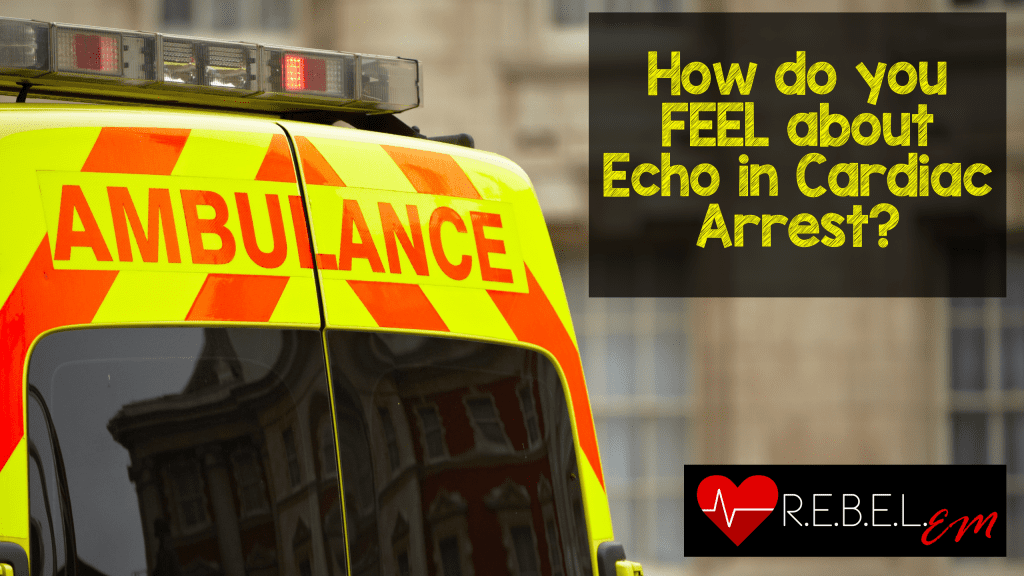
 Background: Focused use of ultrasound in resuscitation of patients with shock and cardiac arrest has become increasingly embraced in both the emergency department (ED) as well as in the prehospital setting. Application of ultrasound, particularly of echocardiography, has the potential to identify treatable causes of shock and arrest, identify shockable rhythms and identify the presence of mechanical activity. All of these can affect management decisions and, potentially effect outcomes. Recent studies have led to concerns that integration of point of care ultrasound (POCUS) in cardiac arrest increases pauses in compressions. Thus, it is important to establish what POCUS adds to shock and arrest management.
Background: Focused use of ultrasound in resuscitation of patients with shock and cardiac arrest has become increasingly embraced in both the emergency department (ED) as well as in the prehospital setting. Application of ultrasound, particularly of echocardiography, has the potential to identify treatable causes of shock and arrest, identify shockable rhythms and identify the presence of mechanical activity. All of these can affect management decisions and, potentially effect outcomes. Recent studies have led to concerns that integration of point of care ultrasound (POCUS) in cardiac arrest increases pauses in compressions. Thus, it is important to establish what POCUS adds to shock and arrest management.
Study Protocol: EMS arrival was initially followed by standard management and emergency physician (EP) echocardiography. In cardiac arrest cases, echo was performed during rhythm checks of < 10 seconds. One of three standard views (subcostal, parasternal or apical) views were obtained. Features noted were the presence or absence of cardiac motion, ventricular function quality, right ventricular dilation or pericardial fluid.
Article: Breitkreutz R et al. Focused echocardiographic evaluation in life support and peri-resuscitation of emergency patients: a prospective trial. Resuscitation 2010; 81: 1527-33. PMID: 20801576
Clinical Question: Is focused echocardiographic evaluation in life support (FEEL) feasible in prehospital resuscitation?
Population: Patients with ongoing CPR or patients judged to be in a “resuscitation state” (profound hypotension, severe dyspnea/tachypnea, impaired consciousness with a reduced Glasgow Coma Score, cyanosis or SpO2 <92%, HR > 100 bpm or <60 bpm) by the emergency physician from August 2002 to December 2007.
Outcomes: Rate of obtaining quality images, presence of cardiac activity in patients in cardiac arrest, whether ultrasound images affected management
Design: Prospective, multi-system (4 EMS providers), observational study
Excluded: If patient refused echocardiography
Primary Results:
- 230 patients included in the study
-
204 patients underwent FEEL protocol
- Cardiac arrest: 100
- Shock state: 104
Critical Results:
- Obtained quality images: 96%

-
Perceived change in management
- Patients with shock: 66%
- Patients with cardiac arrest: 89%
Strengths:
- Asked a clinically important questions
- Data collected prospectively
Limitations:
- A primary outcome of good neurologic function would have been more meaningful
- No randomization and no comparison group
- Total number of patients was rather small
- Accuracy of diagnosis was not independently reviewed at later dates to confirm the correct diagnosis and management decisions were made. This was all at the discretion of the treating provider.
- EMS included paramedic crew and an EP trained in performing resuscitation echocardiography, having undergone standard FEEL training program and independently interpreted and acted upon echocardiographic findings. Because this system is not in place in most pre-hospital systems, generalizability is limited.
- Absence of gold standard for US images
Authors Conclusions:
“Application of ALS-compliant echocardiography in pre-hospital care is feasible, and alters diagnosis and management in a significant number of patients. Further research into its effect on patient outcomes is warranted.”
Discussion:
- In 97/100 patients in the CPR group, no central pulse was palpable further confirming that digital pulse checks are not ideal in low flow states
- In patients with suspected PEA, cardiac motion on POCUS was due to : Severely decreased LV function (59%) and Pericardial tamponade (9.8%).
- Pericardial tamponade was identified in 5/38 Pseudo-PEA patients (13%) and 3/37 asystole patients (8%). In none of these patients were collections demonstrated by ECG or other standard peri-resuscitaiton investigations
Our Conclusions:
We agree with the authors. Pre-hospital echocardiography is a feasible intervention in a system with well-trained sonographers. Use of echo in cardiac arrest has the potential to identify important findings that can change care.
Potential to Impact Current Practice:
The most stunning findings in this study is the high rate of cardiac activity in patients thought to be in PEA (74.5%) or asystole (35%). Suspected PEA is often simply profound shock and asystole is often fine ventricular fibrillation. Identification of cardiac activity in these scenarios changes the interventions that can be applied and may lead to improved outcomes. The REASON trial found that 54% of patients with suspected PEA and 10% of suspected asystole patients had mechanical activity (Gaspari 2016). Given the low reliability of standard methods for determination of PEA (fingers checking a pulse) and asystole (appearance of cardiac tracing), US should be widely applied to determine the actual functioning of the heart.
Bottom Line:
POCUS is a powerful tool in cardiac arrest care but is only useful if the information obtained from it is acted upon. In a small number of cases, cardiac ultrasound will reveal potentially reversible pathology in the cardiac arrest patient. Lastly, it is clear that fingers are not accurate in assessing the presence or absence of a pulse in patients in extremis. It’s time to abandon fingers for the pulse check and embrace more advanced technology.
For More on This Topic Checkout:
- REBEL EM: Beyond ACLS: POCUS in Cardiac Arrest
- REBEL EM: The REASON Trial: POCUS in Cardiac Arrest
- Core EM: ED POCUS in OHCA – The REASON Study
Post Peer Reviewed By: Salim R. Rezaie, MD (Twitter: @srrezaie)
The post How Do You FEEL About Echo in Cardiac Arrest? appeared first on REBEL EM - Emergency Medicine Blog.
